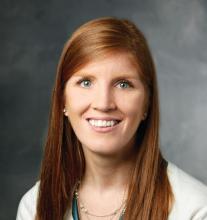CORRECTED April 7, 2024 // An earlier version of this article misstated the clinical factors of children with CNO that were significantly associated with the need for second-line treatment, as well as the scope of assessments of aspects of disease involvement and their relationship to total number of days on NSAID monotherapy and the odds of needing a second-line treatment.
Children with chronic nonbacterial osteomyelitis (CNO) who had symmetric bone lesions or multiple affected body regions were more likely to need second-line treatment than were patients without these features, according to findings presented at the annual scientific meeting of the Childhood Arthritis and Rheumatology Research Alliance.
CNO is an auto-inflammatory condition that results in sterile inflammatory bone lesions and most commonly affects the long bones of people who are skeletally immature. After a first-line treatment of nonsteroidal anti-inflammatory drugs (NSAIDs), second-line treatments per CARRA guidelines typically include methotrexate or sulfasalazine, tumor necrosis factor (TNF)–alpha inhibitors, and bisphosphonates.
“Since it’s common for there to be long delays before diagnosis of CNO, it is important to start an effective treatment promptly,” Katherine D. Nowicki, MD, of Children’s Hospital Colorado, Aurora, told attendees. “While we have guidance on which treatments to use, it remains unclear which patients are most likely to respond to NSAIDs and which patients will require a second-line treatment.”
Findings Helpful for Counseling
Melissa S. Oliver, MD, MS, assistant professor of clinical pediatrics in rheumatology at Riley Children’s Health at Indiana University Health, Indianapolis, who was not involved in the research, said the findings of this study are helpful in “counseling families and patients at that initial visit and having a lower threshold to start a second-line agent if NSAID monotherapy is not working well.”
There are no clinical trials on patients with CNO, Dr. Oliver said, so very little data exist for guiding clinicians on the best therapy to use and how long to keep patients on therapy while minimizing risk for flare when coming off therapy.
A key clinical takeaway for clinicians is being able to tell patients with unifocal disease that they may not need to be on NSAIDs for a long period and can still do well, Dr. Oliver said. For patients with multifocal disease with symmetric bone lesions or multiple regions involved with CNO, “pediatric rheumatologists should have a lower threshold to start a second-line therapy for these patients,” she said.
To better understand how different clinical characteristics predict treatment needs, the researchers conducted a retrospective chart review of 234 patients who received a CNO diagnosis before age 18 and who established care in the Children’s Hospital Colorado’s CNO multidisciplinary clinic between January 2005 and July 2021. After excluding 70 patients, primarily due to inadequate follow-up for assessing treatment response, the researchers included 164 patients whose records they reviewed through January 2022.
The researchers assessed how multiple aspects of disease involvement, including unifocal or multifocal at diagnosis, ever having symmetric bone lesions, number of regions ever affected by CNO, complications, and disease activity at most recent follow-up, to determine their relationship to the total number of days on NSAID monotherapy and the odds of needing a second-line treatment.
Among the 164 patients in the study, 32 had a short course of NSAIDs (3-7 months), 62 had a long course of NSAIDs (7 or more months), and 70 received second-line treatment.


